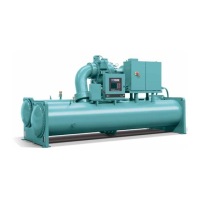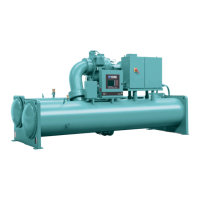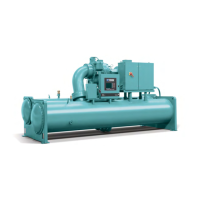JOHNSON CONTROLS
11
SECTION 1 - INTRODUCTION
FORM 160.75-N1
ISSUE DATE: 04/15/2019
1
Relieve pressure as follows:
1. Check the working space to make sure that it is
open and has a good ventilation; if not, connect a
hose or pipe to the valve (Item 5) and route it to
outside.
2. Slowly open the valve (Item 5) until fully opened.
3. Monitor the pressure gauge (Item 2). The pressure
should decline gradually.
4. When the pointer of pressure gauge does not
move and no nitrogen comes out of valve (Item
5), it means that no positive pressure exists in the
waterbox.
5. Now it is safe to remove the ange cover (Item 6)
or sealing cap (Item 9).
6. Close the valve (Item 5) and remove the warning
tag (Item 1).
Shipment Form 2/3/7/9
All openings on the compressor, shells including evap-
orator and condenser, and oil reservoir are closed and
charged with nitrogen (2 psig to 3 psig). To remove the
closures, sealing caps, or sealing plug under pressure is
extremely dangerous, and may cause severe injury or
death to the operator or people in site.
Before trying to remove the closures,
caps, or plugs on compressor and shells,
relieve the pressure in compressor, shells,
or system that are charged with nitrogen
by opening the valves on them slowly until
fully open.
When relieving the pressure from com-
pressor, shells, or system, conduct the
nitrogen to outside to prevent the potential
risk of asphyxiation.
Shipment Form 1/10
The unit is shipped with refrigerant charge; it is not
needed to relieve the pressure. So DO NOT try to open
any valves to relieve pressure or open closures, cap, or
plugs on the compressor, shells, and elsewhere on the
system.
Reclaim the refrigerant in the system before any ser-
vice activities being done to refrigeration system. Fully
relieve system pressure and then repair.
The unit is charged with tons of refrig-
erant; once an uncontrollable leak is
found, inform all of the relevant people
to evacuate from the building to prevent
from asphyxiation.
Never touch the refrigerant that is leak-
ing, especially the liquid refrigerant; this
will cause severe freezing to your hands
or body.

